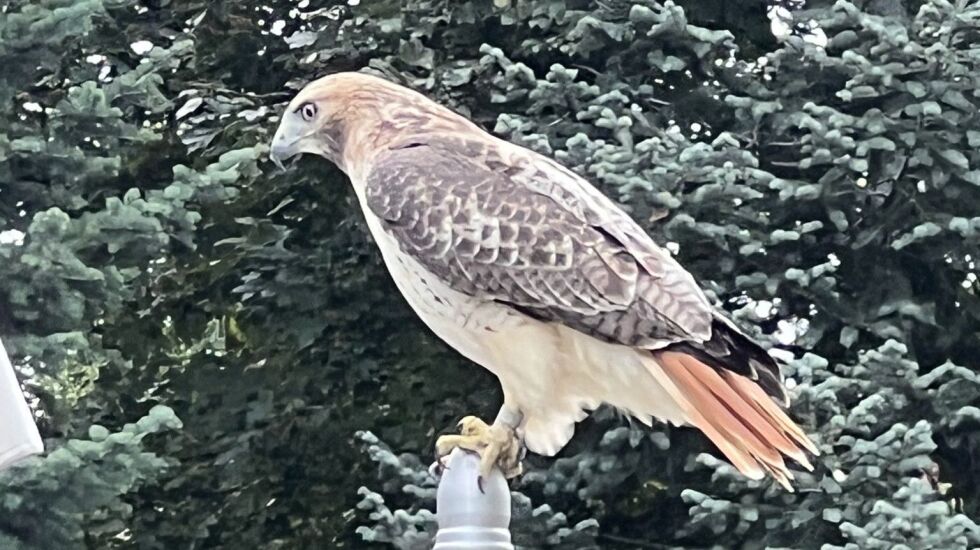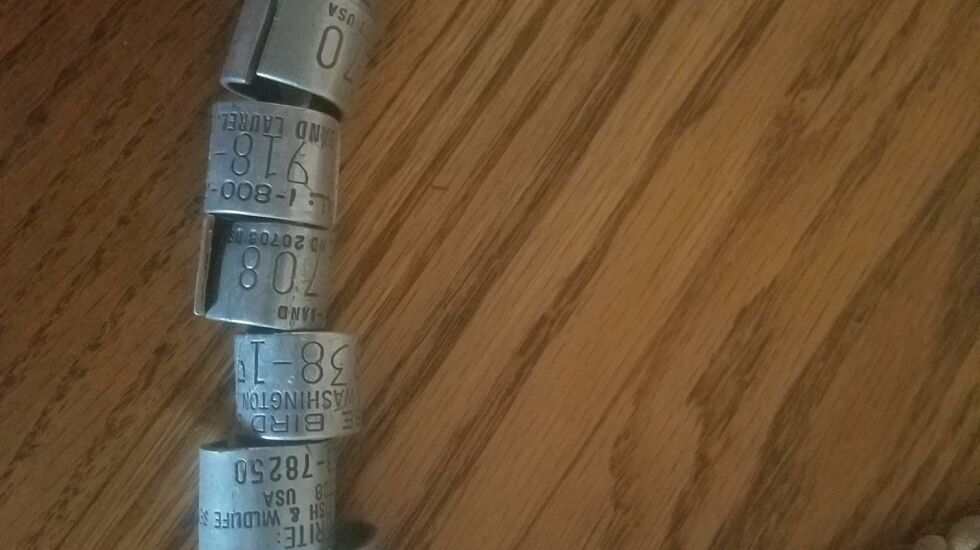
Brian Black was playing tennis at the Saddle and Cycle Club near Foster and the lakefront Monday when he was aced by an adult red-tailed hawk.
“It swooped down and landed on an outdoor umbrella,” Black said. “It stayed a good long time like it was judging my bad tennis, but not as harshly as I judge my tennis.”
When I wondered what made him take a photo, he said, “My cousin Danny and his nephew have gotten into birding. They made me pay more attention to interesting birds.”
That cousin is Dan Bernstein, a midday host on The Score. He noticed the leg band, then messaged on X wondering if Black should report the band.
Yes on reporting the band, if you get identification. But I couldn’t read the band.
“I can’t read the band# either, which is too bad,” emailed Mary Hennen, assistant collections manager, birds, for the Field Museum and director of the Chicago Peregrine Program. “Getting that information would allow us to figure out where the bird came from. Most banding stations focus on passerines but occasionally they do get raptors but I doubt they get many red-tails. Banding stations use mist nets and that’s not something a red-tail is likely to fly into.
“Even if you found someone who was locally trapping and banding red-tailed hawks, without the band information there is no way to confirm the bird was banded by that person.”
“I know they band red-tailed hawks and other raptors they catch and move (release) away from O’Hare airport, but in the past they’ve used numbered and colored patches in the wings,” emailed Alan Anderson, research committee chair for the Chicago Audubon Society. “I’m not sure who leg bands RTHA locally ( I’m sure there are a number of banding stations in the Midwest that do).”
RTHA is birding shorthand for red-tailed hawk.
“I’m not sure I (or anyone) can add much to what Alan already told you,” Hennen emailed. “Even though it doesn’t have a wing tag it could still be an O’Hare trapped bird. They (USGS) haven’t used the wing tags in years - that was part of an older study but, as red-tails can live up to 35 years, every once in a while an individual with a wing tag shows up.”
As to this red-tail, she added, “I’m not sure the bird in the photo is a migrant since it is an adult. But that’s not to say it couldn’t have been a migrant when trapped. No way to know without reading the band.”
Passerines, as Hennen mentioned, are often captured for banding with mist nets. I never helped or observed that. Passerines or perching birds are any member of Passeriformes, “the largest order of birds and the dominant avian group on Earth today,” as britannica.com puts it. Basically, they’re the birds at your feeders.
I tagged along/helped on a couple days of banding scaup (bluebills) a decade ago along the Illinois River near Havana. Those diving ducks were captured in baited wire traps, resembling large minnow traps.
Seven years ago, I tagged along/helped with banding Canada geese on the Chicago lakefront, pretty cool because I’ve reported such bands and have helped readers to report them. Plus I got to watch goose-whisperer Brett Dorak circle close enough to net geese.

There’s a convergence between birders and waterfowl hunters on banded birds. Birders tend to report bands they’ve photographed or observed through binoculars. Hunters find bands on birds they’ve killed.
Bands are valued by waterfowl hunters as “jewelry.”
I have a little “jewelry:” two leg bands from wood ducks along with leg bands and neck bands from a pair of snow geese. The snow geese bands came while hunting in southern Illinois. As the youngest in our group, when we sailed two into a marsh, I was sent to find them. I found both, each had neck and leg bands.

After reporting bands, there’s the anticipation and wait to find out where they were banded and other information.
“The answer to the why band question would be the same no matter what species you’re talking about,” Hennen emailed. “Because we can gain a wealth of information about so many aspects of a bird’s life - longevity, dispersal and migration patterns, survival rate etc... For all we know it could have been a bird that was unbanded and got injured, went to a wildlife rehab facility and then was banded when released.”
The start for reporting bands is reportband.gov.







